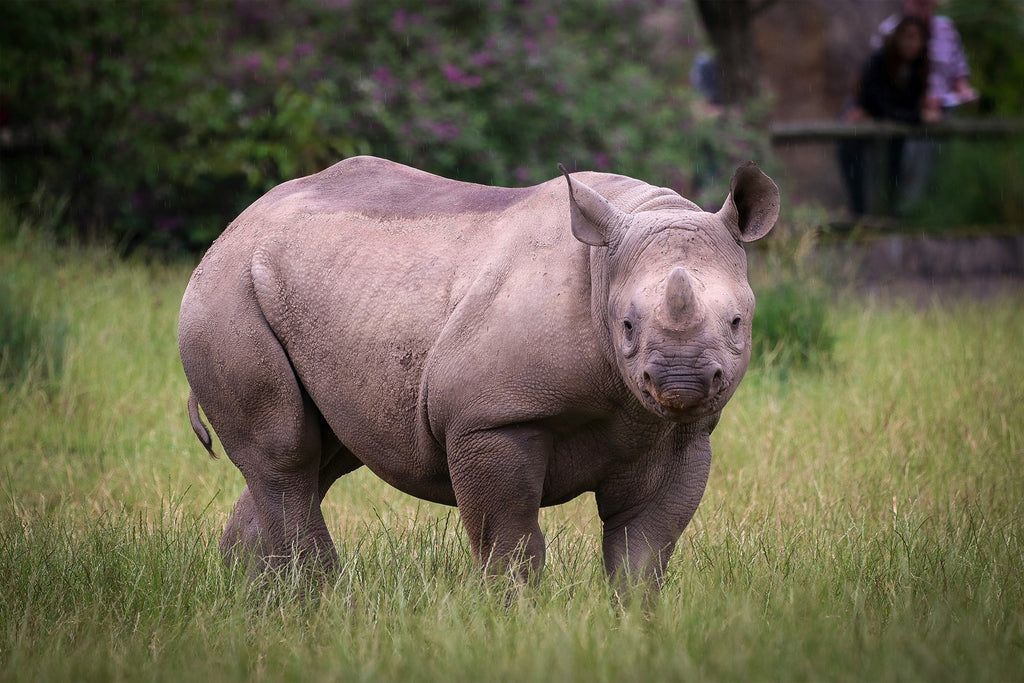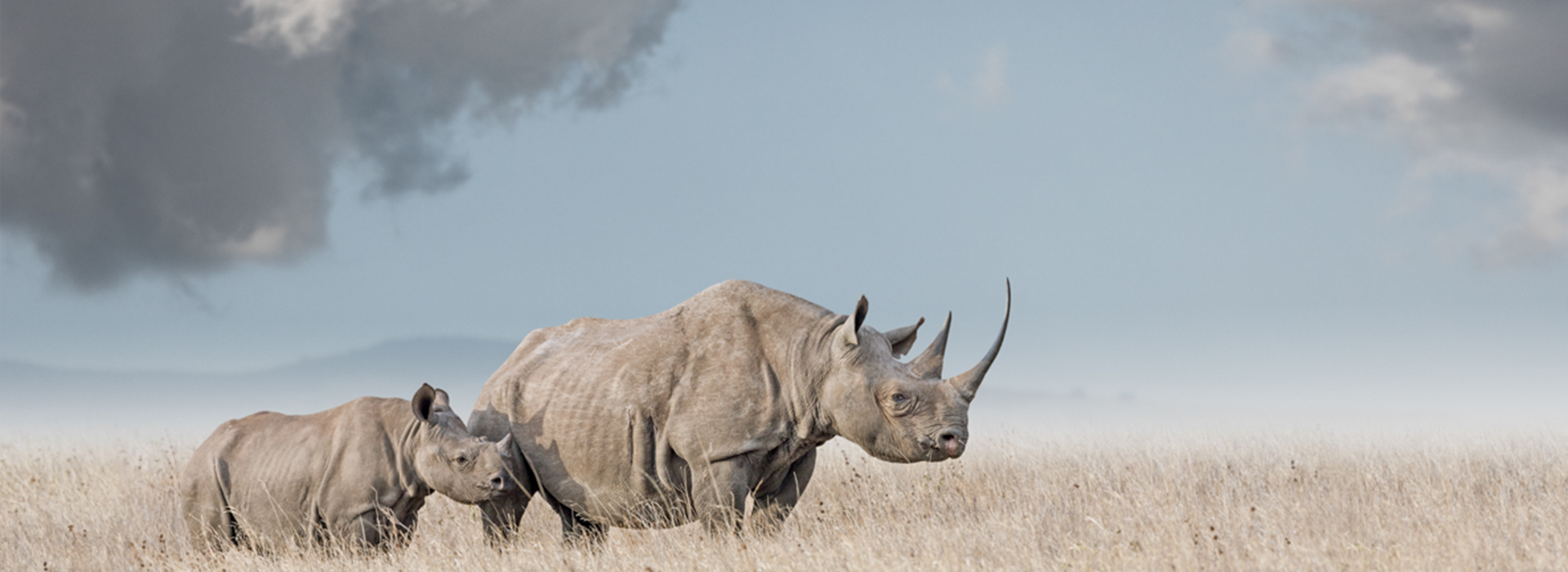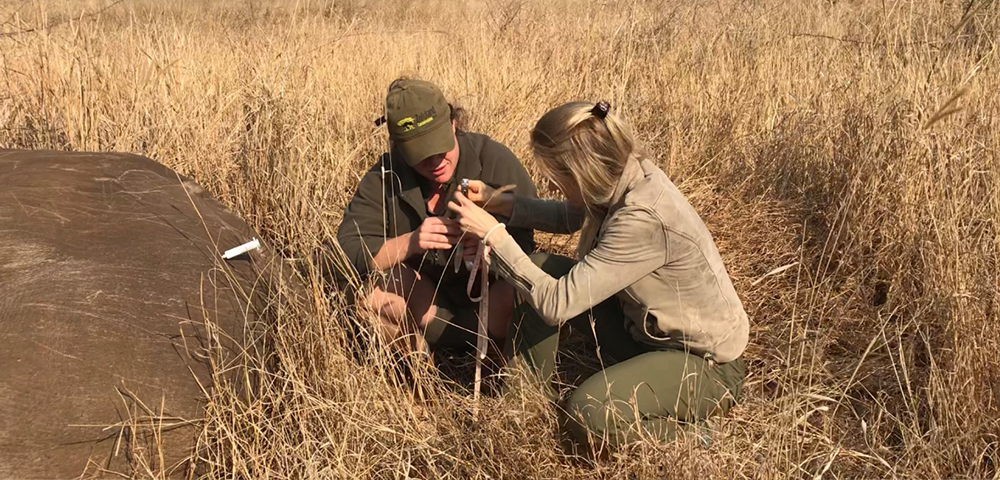Black rhinoceros | Population, Habitat, & Facts

SCIENTIFIC NAME
The black rhinos are known scientifically as 'Diceros bicornis' - The word 'Dicero' stemmed from the Greek word “di”, which means “two” and “zeros”, which means “horn”. 'Bicornis' also means the same thing just in Latin with “bi”, meaning “two” and “corners”, meaning “horn.”
SUBSPECIES
- South-western black rhino (D. b. bicornis)
- East African black rhino (D. b. )
- Southern-central black rhino (D. b. minor)
BIOLOGY
The Black rhinos are the smaller of the two African rhino species; they are also known as the hook-lipped rhino. This is because they possess a hooked upper lip rather than the square upper lip that identifies the white rhino. The black rhinos are browsers. They use their pointed (prehensile) lips to feed on leaves from bushes and trees by grasping and holding them. They feed on herbaceous plants but have a preference for acacia; they are also in possession of two horns on three occasions. The third horn is usually a smaller posterior horn.

HABITAT
The black rhino lives in Africa, majorly in grasslands, savannas, and tropical bushlands.
PHYSICAL DESCRIPTION
The reason behind the name is unknown because the black rhinos are not black. The species probably derived its name so it could be distinguished from the white rhino or from the dark-colored local soil that covers its skin after wallowing in mud. They have a prehensile or hook-lipped rhinoceros. The upper lip of the black rhino is adapted for feeding from trees and shrubs.
SIZE
The black rhino is much smaller compared to the white rhino. An adult black rhino will reach 1.5 meters in height and about 1.4 tonnes in weight.
HORNS
They possess two horns of which The front horn being the longer of the two horns, averaging 100 cm in length, and the shorter horn measuring up to 50 I'm. The black rhino is endangered, with poaching for their horns posing a constant threat to their survival.
LIFESTYLE
The Adult black rhino is called 'bull' and is mostly solitary. While the females are more social. You will find a mother rhino and her daughters together for long periods. However female rhinos without offspring and mates join up with a neighboring female also without offspring.
LIFE CYCLE
Black rhinos live up to 40-50 years of age.
The female rhinos reach sexual maturity at 4-5 years, but can only have their first calf until they are 5-7 years old.
The males on the other hand can only claim a territory or mate when they reach 10-12 years. When they reach this age they go through a completing process to pick a mate. In the process of choosing a mate, two males will compete. This competition could even lead to the death of one of the rhinos. After one of them must have won the competition and gotten the female rhino as his mate and they bear a calf. They breed throughout the year and have a gestation period between 419 and 478 days (15-16 months). The period between calf deliveries could vary from two and a half to three and a half years.
Black rhino calves begin to wean at about 2 months of age.

POPULATION AND DISTRIBUTION
Today, the black rhino population is more than 6,000. The black rhino would however have gone extinct if not for great conservation efforts. Before the 20th century, there were over a hundred thousand black rhinos; this number was greatly reduced by a staggering 98 percent in thirty-five years (1960 and 1995) when European hunters and settlers massacred most of them for several reasons, poaching for their horns being one of them. The species have however drastically increased by a hundred percent of 2500 that it was at the beginning of the twentieth century using the conservation efforts in Africa.
DISTRIBUTION
Black rhinos were once found throughout sub-Saharan Africa. However, due to the relentless hunting by European settlers, their numbers quickly reduced. In 1960 there were still bout 70000 black rhinos.
At least until a great poaching epidemic hit, which started in the early 1970s. This poaching pandemic effectively eliminated most black rhinos, especially those outside conservation areas as well as severely reducing their numbers within national parks and reserves.
In the early 90s, only 2,475 black rhinos were recorded but now we can brag of over 5000 black rhinos due to successful conservation and anti-poaching efforts.
The species is currently found in patchy distribution from Kenya down to South Africa. However, almost 98% of the total population is found in just 4 countries: South Africa, Namibia, Zimbabwe, and Kenya.
DISTRIBUTION OF THE THREE SUBSPECIES
Southern-central black rhino: Most numerous of the subspecies. They can be found in South Africa, Zimbabwe, Southern Tanzania, Botswana, Malawi, Swaziland, and Zambia.
South-western black rhino: Found In arid and semi-arid Savannas, Namibia, and South Africa.
East African black rhino: Kenya, with smaller numbers in northern Tanzania.
HOW THREATENED IS THE SPECIE
However, the black rhino is still considered critically endangered, and a lot of work remains to bring the numbers up to even a fraction of what it once was—and to ensure that it stays there. Wildlife crime—in this case, poaching and black-market trafficking of rhino horn—continues to plague the species and threaten its recovery.
POACHING
This refers to the uncontrolled hunting for the horns of the black rhino. It was what led to the great reduction in the black rhino population in the colonial era. It is also now a major threat.
HOW USEFUL IS THE RHINO HORN?
- Powdered horn is commonly used in traditional Asian medicine as a supposed cure for a range of illnesses i.e hangovers, fevers, and even cancer.
- The horn has also recently been known to signify a symbol of death in Vietnam by upper-middle-class men.
The killing of black rhinos has increased over the years and an organized criminal network has even become more involved in the poaching of rhinos and the illegal trade in rhino horn.
The Black rhinos have two horns which make them a beneficial target. Two horns are better than one after all. A wave of poaching for rhino horn is currently passing through Kenya, Tanzania, Zambia's Luangwa Valley, and the Zambezi River, and spreading into Zimbabwe.
Political instability has also greatly hampered rhino conservation projects in Africa, especially in Angola, Rwanda, Somalia, and Sudan.



